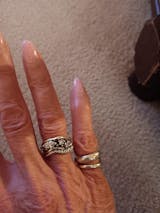Exploring the Rich History and Timeless Elegance of Sterling Silver
In our exploration of significant jewelry pieces, the comparison between sterling silver versus silver emerges as a recurrent theme. These days, the discerning eye of any jewelry enthusiast readily detects the prevalence of sterling silver in the market. But what sets this alloy apart from its purer counterpart?
Crafting Durability: The Birth of Sterling Silver
Sterling Silver, born out of necessity, traces its origins to the challenges faced by blacksmiths in Britain centuries ago. Working with silver, a material known for its softness and susceptibility to scratches and dents, posed a formidable obstacle. To surmount this, artisans devised an alloy, blending silver with other metals like copper, nickel, or zinc. This innovation yielded a material that retained the luster of silver while enhancing its durability and resilience: sterling silver.

Sterling Silver: Composition and Utility
The distinction between fine silver and sterling silver lies primarily in their composition. While fine silver mandates a minimum purity of 99.9% silver, sterling silver typically comprises 92.5% silver and 7.5% of other metals. This alloy gained widespread popularity, finding utility not just in jewelry but also in diverse fields such as medicine, dining, and electronics. The versatility and workability of sterling silver made it a favored choice for manufacturers, offering a balance between elegance and practicality.
Embedded within the gleaming surface of sterling silver jewelry lies a subtle indicator of its composition: the hallmark "925," denoting its alloy makeup. This hallmark serves as a reliable guide for discerning consumers seeking assurance of the material's quality and authenticity.
Here's the key takeaway:
-
In terms of Composition, Fine silver mandates a minimum purity of 99.9% silver, while sterling silver comprises 92.5% silver and 7.5% of other metals.
-
Sterling silver is favored by manufacturers due to its workability and versatility, offering a balance between elegance and practicality.
-
Sterling silver jewelry is marked with the hallmark "925," denoting its alloy makeup, serving as a reliable indicator of quality and authenticity for discerning consumers.
Sterling Silver: Timeless Beauty and Enduring Strength
In terms of aesthetics, distinguishing between sterling silver versus silver presents a straightforward task. The alloy's inherent brilliance, owing to its metal blend, renders sterling silver jewelry a timeless choice for daily wear. Its resilience against the rigors of everyday use echoes through generations, as evidenced by the cherished heirlooms of silver spoons and trinkets. While bearing a striking resemblance to pure silver, sterling silver boasts superior durability, capable of withstanding the test of time and handling. If you're eager to explore further, discover the Jean Rachel Sterling Silver collection here.

Comparing Jewelry Care: Sterling Silver vs. Silver
However, when it comes to jewelry care, the comparison between sterling silver versus silver does reveal a distinction. Sterling silver is susceptible to tarnishing if left exposed to extreme temperatures, as oxygen reacts with the metal. Nonetheless, adhering to the manufacturer’s instructions and treating your jewelry with care can resolve this issue. It is crucial to properly care for your silver piece to ensure its longevity. Discover how to care for your silver jewelry here.
For coin collectors and investors, the debate surrounding sterling silver versus silver assumes a pragmatic tone. With minimal requirement for daily use, purists may lean towards the intrinsic value of pure silver, relegating it to secure storage. Conversely, the enduring appeal and practicality of sterling silver find favor among those seeking elegance intertwined with utility.
Here's what you should keep in mind:
-
Sterling silver exhibits resilience against the rigors of everyday use, echoing through generations as evidenced by cherished heirlooms.
-
Sterling silver is susceptible to tarnishing if left exposed to extreme temperatures. Proper care according to manufacturer's instructions can resolve this issue, ensuring longevity.
Silver's Symphony: A Timeless Tale
In essence, the discourse surrounding sterling silver versus silver transcends mere material comparison, encapsulating a narrative of innovation, durability, and aesthetic appreciation. Whether adorning the wearer with timeless elegance or adorning the collector's vault with tangible wealth, both variants of silver weave a tapestry of enduring allure and intrinsic value.
When evaluating the enduring legacy of sterling silver versus silver, it's imperative to acknowledge the historical context that birthed these materials' prominence in the realm of adornment and utility. From ancient civilizations to modern-day artisans, the evolution of silverworking techniques reflects humanity's quest for beauty, functionality, and lasting value. While the allure of pure silver's pristine sheen may captivate collectors and investors, sterling silver emerges as a practical solution to the challenges posed by silver's innate softness and susceptibility to damage. This alloy's resilience and enduring charm have cemented its status as a staple in the world of jewelry and beyond.
Indulge in the timeless beauty of the Jean Rachel Sterling Silver collection here








